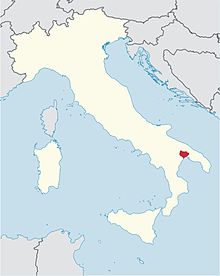Diocese of Castellaneta
|
Diocese of Castellaneta Dioecesis Castellanetensis |
|
|---|---|

Castellaneta Cathedral
|
|
| Location | |
| Country | Italy |
| Ecclesiastical province | Taranto |
| Statistics | |
| Area | 1,043 km2 (403 sq mi) |
| Population - Total - Catholics |
(as of 2013) 128,687 125,861 (97.8%) |
| Parishes | 33 |
| Information | |
| Denomination | Catholic Church |
| Rite | Roman Rite |
| Established | 11th century |
| Cathedral | Cattedrale di S. Nicola |
| Secular priests | 46 (diocesan) 8 (Religious Orders) |
| Current leadership | |
| Pope | Francis |
| Bishop | Claudio Maniago |
| Map | |
 |
|
| Website | |
| www.diocesicastellaneta.net | |
The Roman Catholic Diocese of Castellaneta (Latin: Dioecesis Castellanetensis) is in Apulia. It is a suffragan of the Roman Catholic Archdiocese of Taranto.
Nothing is known of Castellaneta previous to 1080, when it was taken by Robert, Duke of Tarentum, who expelled its Byzantine inhabitants. At this time, possibly, the episcopal see was created; in 1088 Tarentum was made a metropolitan see, and the diocese of Castellaneta was placed under his authority. In 1088 Riccardo the Seneschal, nephew of Robert Guiscard, who happened to be Lord of Castellaneta, granted to the diocese several monasteries and churches which were under his control. A bishop of Castellaneta, Joannes, is mentioned by Ferdinando Ughelli as first bishop of the diocese in 1088, but without documentation.
In December 1100, Amuris, Bishop of Mottola and Castellaneta, who had been given the Church of Castellaneta to rule by Archbishop Alberto of Taranto, granted the Church of S. Matteo Apostolo to the monastery of Cava, with the permission of Duke Roger and Riccardo Siniscalco. Mottola is only six miles east of Castellaneta. It appears that the diocese of Castellaneta was vacant, and that the Archbishop had assigned its administration to Amuris; the alternative theory is that Archbishop Amuris united the two dioceses, but such an action is a papal function. There is a record of an otherwise unknown Bishop of Mottola, who died in 1040; his successor was a certain Liberius.
![]() This article incorporates text from a publication now in the public domain: Herbermann, Charles, ed. (1913). "". Catholic Encyclopedia. New York: Robert Appleton.
This article incorporates text from a publication now in the public domain: Herbermann, Charles, ed. (1913). "". Catholic Encyclopedia. New York: Robert Appleton.
...
Wikipedia
